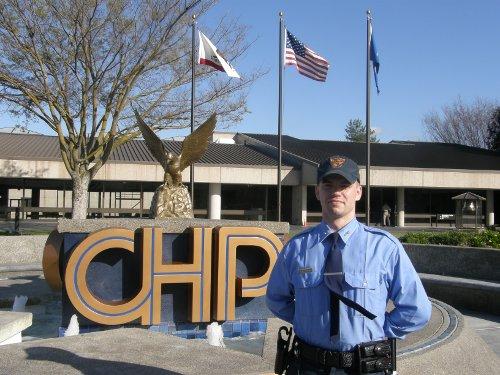
Editor's note: The following is a first-person account of Lake County News correspondent Tera DeVroede's participation in the California Highway Patrol's recent media day on March 10.
WEST SACRAMENTO – Sore muscles, tales to tell and a great appreciation for what it takes to become a California Highway Patrol officer are only some of the many things I gained after attending the fourth annual Media Boot Camp.
The all-day event was at the only live-in CHP Academy in the state – considered one of the finest law enforcement training facilities in the world.
The boot camp began at “0700 hours” sharp, or 7 a.m., in West Sacramento, so my drive from Lake County began at 4:30 a.m. that Wednesday, March 10. CHP Public Information Officer Steven Tanguay accompanied me to the event and doubled as my photographer.
The academy grounds is a completely self-contained facility on 457 acres and consists of administration buildings, dormitories, recreation rooms, a cafeteria, museum, classrooms, indoor and outdoor firing ranges, gymnasium, physical training facility, motorcycle training network, K-9 training area, scenario village, an emergency vehicle operations course with a high-performance driving track, two skid recovery practice areas and a defensive driving course.
The CHP invited 24 different media outlets, so both reporters and cameramen alike marched together throughout the day.
The morning flag ceremony demonstrated the discipline and seamless formation of the company of cadets that marched around to raise the flags.
The cadets go through an extensive application process in order to attend the CHP Academy. Once accepted, they spend about six months in the academy in their dormitories.
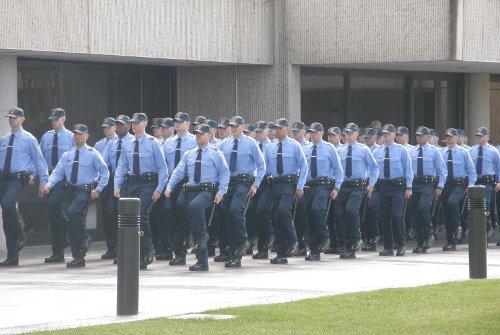
Currently, there are 7,868 uniformed CHP personnel in California as of February, compared to the 23.7 million licensed drivers that the Department of Motor Vehicles said were in California in 2009.
As of February CHP employs 617 female uniformed personnel and 7,035 male personnel. The cadets train hard to earn their uniforms.
“Even if someone is in the best physical condition of their life, the CHP academy can still be a challenge,” said Tanguay.
CHP officials reported that there are anywhere between 80 and 200 cadets in the academy at one time.
“They train hard and learn to trust each other with their lives,” Tanguay said.
The cadets will learn to perform a plethora of different duties ranging from the typical motorist services to handling a sliding vehicle in a high-speed pursuit.
“Safety, Service and Security” is the CHP motto.
While they're in the academy, cadets may only have limited visitations with family and friends. Such visits are limited to Wednesday evenings and weekends.
“One of the hardest parts is being away from your family,” said Tanguay.
During their time at the academy cadets cannot afford to slip up – failing just one test could justify booting a cadet out of the academy, leaving them to have to apply from the start if they weren’t discouraged. While cadets are at the academy, they are constantly alert and following orders.
First and foremost, the drill officer had to teach all of us how to follow their commands and march in company – outside, just like the cadets. The cadets obeyed the muttered odd language of the man shouting commands.
The weather was forecast as cloudy with potential rain but the sun shone bright. Still, the wind was chilled and we all had our jackets. Our breath created little trails of warm air on that chilly morning.
After realizing that some people couldn’t tell their right from their left, we were marched, double time, into the gymnasium. There the true experience began – PT, or physical training. Tanguay was already chuckling at the crowd of uncoordinated media members.
Sgt. Marc Gomez led PT and battered us with loud commands. With one officer on stage demonstrating the exercise movements, we media folk had to follow along. All of our jackets came off.
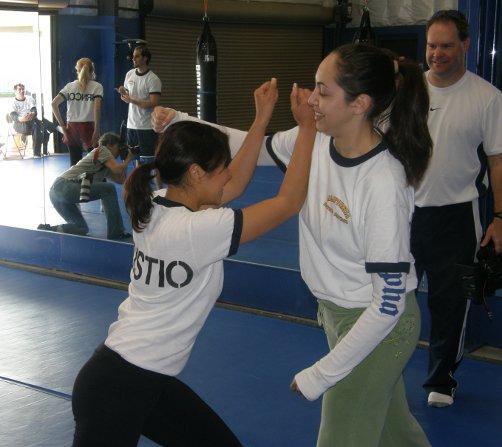
“Everything you are doing today is just like the training our cadets go through,” said Sgt. Gomez. “We didn’t change anything up too much.”
There was a wide variety of participants, from young to old and fit to not-so-fit. I’d say I was a young, so-so-fit participant. I, along with many others, was winded after simply following along during the demonstration.
We endured 13 solid minutes of crunches, leg lifts, jumping jacks, a variety of push ups and a few others.
The cadets must be fit and have to carry a belt of heavy equipment including their 40 caliber Smith & Wesson pistol, handcuffs, pepper spray, Taser and flashlight. They often will have to run wearing heavy leather boots in pursuit of a suspect as well.
With my face flushed from exertion, I hugged the water fountain on the way out of the gym. I was worried that the day had only just begun.
Then we were treated to a go on the academy's obstacle course. I went over a 4-foot wall, over and under bars, and zigzagged my way to the end in 38 seconds – 44 seconds including my penalties.
Although I felt nauseous from my morning coffee and lack of water, I pushed through and marched on to the next challenge. Then, we were split up into three different groups to rotate between the following three activities.
Guns, cars and self-defense
We were directed past the cracking, active firing range towards training area, Advanced Officer Safety Training (AOTS). Here they taught us some self-defense techniques. That was one of my favorite parts of the boot camp.
CHP officers have to be able to defend themselves – even in the event that they can’t reach their firearm.
The CHP made nearly 2.7 million arrests in 2009, according to State Wide Integrated Traffic Records System reports, or SWITRS reports.
Handling a gun calls for one to be able to handle shooting someone who is threatening their lives. The Force Option Training Simulator is one tool cadets train with to be able to make the split second decision whether or not to fire their weapon.
Although I was a pretty good shot, I was hesitant to pull the trigger a number of times when it would have been warranted.
Preventing and prosecuting drunk drivers is another big duty CHP officers have. According to SWITRS, the CHP made 94,732 DUI arrests in 2009. In 2008, 1,355 persons were killed in an alcohol-related traffic collision – 790 of those victims were killed by DUI drivers.
Several CHP officers gave us a crash course in handling DUI cases. We learned about nystagmus, which is involuntary jerking of the eye and I also conducted and was submitted to a couple field sobriety tests – all of which I passed of course.
After all of these events, I was very hungry and happily followed everyone to the cafeteria. The food was good and it hit the spot.
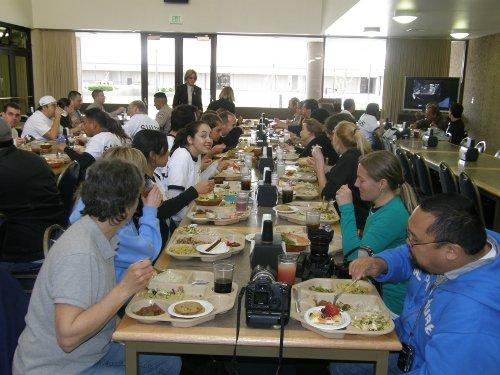
We were treated to a video about the CHP and then a short meet and greet with Assistant Commissioner Ramona Prieto. She opened up the floor for questions.
“We like to see the bonding between public information officers and the media,” said Prieto. “We strive for transparency.”
Anywhere between 20 and 30 percent of a class of cadets drop out of the academy for a variety of reasons, she said.
After lunch, we were split up into two groups to rotate between the next activities. I was in the group visiting the skid pan after lunch.
The skid pan is a driving course where the track is watered down and the cars sport slick tires – to promote sliding. Most CHP officers agree that this test sends the most cadets home over any other. It is a skid recovery practice area. Here is where the cadets train in correcting a sliding vehicle while in pursuit.
Four different squad cars were ready to go and we all loaded up with a CHP officer at the helm. I got shotgun and had a lot of fun. One reporter in the back seat started to feel carsick.
After a few 180s, 360s and a lot of sliding, they offered us a go at the wheel – and I was first to jump on the opportunity. I spent the most time out there out of everybody in my group having the time of my life and getting pretty good at spinning too. I was surprised that cadets only get four shots to pass the skid pan exam.
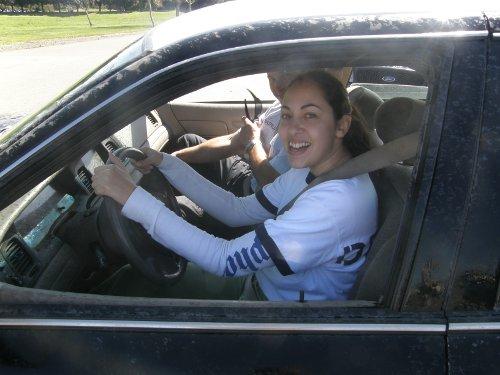
The next activity brought my adrenaline rush down to a somber state when we came to a staged vehicle collision – with victim, fake blood and crashed cars.
The CHP reported that in 2008 approximately 3,401 peopled died in traffic collisions.
In this scenario, the victim was hit head-on by an underage drunk driver. I assisted in removing the female victim from the crunched car and getting her on the stretcher. Another media member issued our newly-learned field sobriety tests to the “underage drunk driver,” which was actually a female CHP officer.
The boot camp came to a close after the staged crash and we all headed back to the cafeteria, where we would have the chance to meet some of the cadets that were currently training.
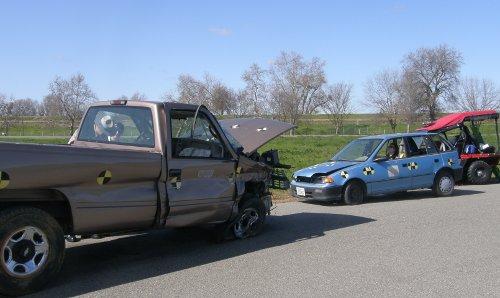
I had the opportunity to interview a cadet from Clearlake, Cadet Joseph Eastham, 31.
Eastham entered the academy on Jan. 4 and is scheduled to graduate on July 9.
“I feel, even after only two and a half months, that I would step in the line of fire for my fellow cadets and that they would do the same for me,” he said. “We became very close very quickly.”
His wife of nine years, Cherie, 27, and two sons live in Clearlake and his parents own a house in Lucerne. Their oldest son, Deven, is 8 and son Hayden is 7. I contacted her after the boot camp to see how they felt about her husband's six months away from home.
“I wasn’t against it, I was worried about it,” she explained. “We have rarely spent time away from each other and the idea of being apart for six months was terrifying. I would have to learn to be a single mother and be apart from my best friend.”
She said that Hayden and Deven both handle their father’s absence very well, but their youngest doesn’t understand where he is or why.
Tanguay agreed that it was just as hard on his family when he was training in the academy.
Cherie Eastham is fully supportive of her husband's choice to become a CHP officer.
“I am so proud of my cadet,” she said. “I know this is what is right for him as a career choice and I know that this is the right decision for our family. I couldn’t be more excited to pin the CHP badge on him in July.”
Joseph Eastman said he isn't sure where he'll be posted after he graduates. That decision will be based on the needs of the agency and his performance.
After the short interview, Tanguay and I were given a tour of Eastham's living quarters and some of the classrooms he attends. Cadets are only allowed one cell phone, one family photo and one clock radio.
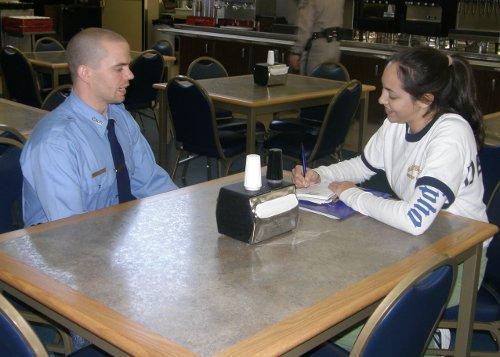
Tanguay was walking down memory lane throughout this process, remembering when he was a cadet from March to September of 1997.
“I still got that knot in my stomach when we walked behind the gym for PT,” he said.
It takes a lot of physical training, mental control and teamwork to become a CHP officer. And though I was sore for a whole week after this event, I truly appreciate the CHP Academy – one of the finest law enforcement training facilities in the world.
For more information about the CHP and the agency's many programs, services and outreach efforts, www.chp.ca.gov.
E-mail Tera deVroede at This email address is being protected from spambots. You need JavaScript enabled to view it.. Follow Lake County News on Twitter at http://twitter.com/LakeCoNews and on Facebook at http://www.facebook.com/pages/Lake-County-News/143156775604?ref=mf .

 How to resolve AdBlock issue?
How to resolve AdBlock issue? 





